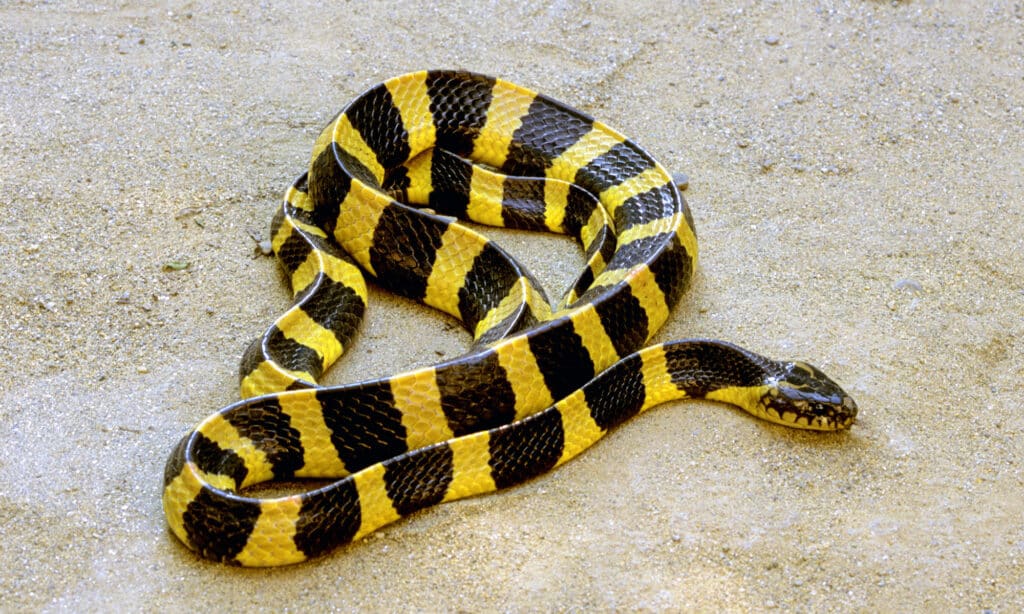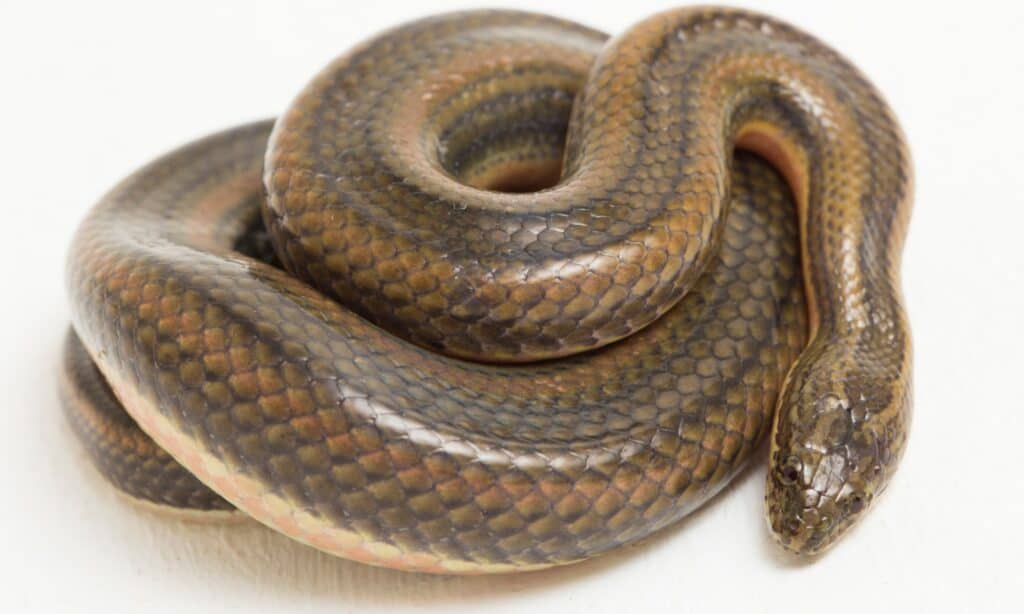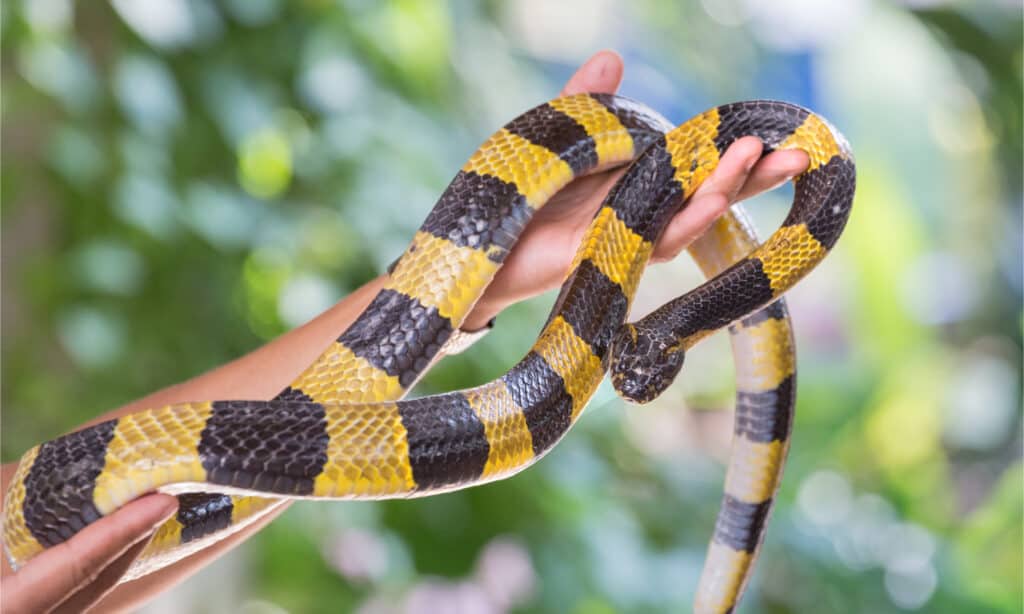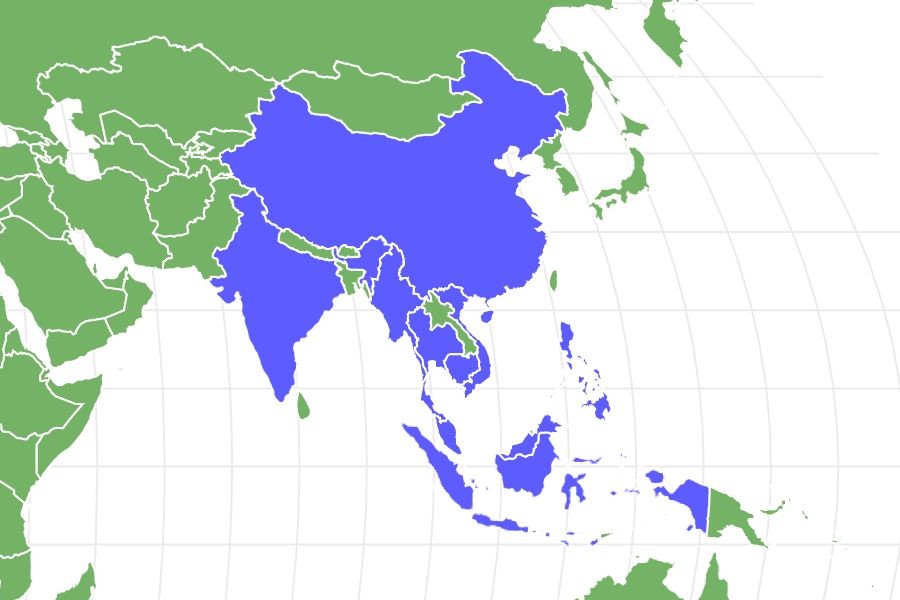Banded Krait
Bungarus fasciatus
What often prevents more people from falling victim is that the banded krait does not always inject venom in a defensive bite. It saves the venom for hunting prey instead.
Advertisement
Banded Krait Scientific Classification
- Kingdom
- Animalia
- Phylum
- Chordata
- Class
- Reptilia
- Order
- Squamata
- Family
- Elapidae
- Genus
- Bungarus
- Scientific Name
- Bungarus fasciatus
Read our Complete Guide to Classification of Animals.
Banded Krait Conservation Status
Banded Krait Facts
- Prey
- Some of their favorite food includes rat snakes, sunbeam snakes, rainbow water snakes, and cat snakes. They also consume fish, skinks, frogs, and eggs.
- Main Prey
- Other snakes
- Name Of Young
- Habitat loss
- Group Behavior
- Solitary/Herd
- Fun Fact
- What often prevents more people from falling victim is that the banded krait does not always inject venom in a defensive bite. It saves the venom for hunting prey instead.
- Biggest Threat
- Habitat loss
- Habitat
- Forests (including mangrove forests), open plains, and agricultural fields and plantations
- Diet
- Carnivore
- Lifestyle
- Nocturnal
Banded Krait Physical Characteristics
- Skin Type
- Scales
- Age of Sexual Maturity
- 3 years
- Venomous
- Yes
- Aggression
- Medium
View all of the Banded Krait images!
The banded krait is among the most venomous snakes in all of Southeastern Asia.
Despite its highly toxic venom, the banded krait is shy and elusive. When approached during the day, it will assume a defensive posture at the first sign of contact. Nevertheless, you would not want to encounter a banded krait in the wild. This article will cover some interesting facts about the appearance, habitat, lifespan, and venom of the banded krait.

4 Banded Krait Amazing Facts
- Very few facts are known about the reproductive behavior of the banded krait, but in the breeding season, the female snake is thought to produce a clutch of anywhere between four and 14 eggs at a time. Upon hatching, the juveniles will soon begin hunting for food without the help of their parents. They reach adulthood at about three years old. The exact lifespan is unknown, but it’s been documented to live around 13 years old.
- The banded krait is a nocturnal species, most active during the nighttime. They spend most of the day hiding in vegetation, pits, or drains.
- The banded krait is known by many local names. In Thai, for instance, it’s called ngu sam liam, which roughly translates as a triangular snake.
- Krait is thought to come from the Hindi word karait, possibly meaning a type of dark venomous snake.
Where to Find Banded Kraits

The banded krait can be found throughout Southeast Asia.
©RealityImages/Shutterstock.com
The banded krait is widely distributed throughout Southeast Asia. The most common habitats include forests, open plains, and agricultural fields and plantations up to an altitude of some 5,000 feet. They are often found near termite mounds or rodent holes close to the water. Some of the countries in which they’re found include:
Scientific Name
The scientific name of the banded krait is Bungarus fasciatus. Bungarus is the Telugu (a South Asian language) word for golden. Fasciatus comes from the Latin word for banded. There are approximately 16 species in this genus, including the Indian krait and the blue krait. There are no recognized subspecies despite its huge range.
This snake is sometimes accidentally mistaken for other species with a similar set of vertical bands. It should not be confused with the many-banded krait, a separate but closely related species. Both are part of the same genus of venomous kraits. Another species with which it’s commonly confused is the banded sea krait, also known as the yellow-lipped sea krait, but this species is part of an entirely separate genus and not as closely related.
Evolution
Fossil records show that snakes first appeared during the Cretaceous period – although they often retained their hind limbs. The earliest true snake fossils come from the marine simoliophiids, the oldest being Hassiophis terasanctus, dated between 112 – 94 million years ago.
Scientists believe that snakes descended from lizards. Pythons and boas, the most primitive snakes, have vestigial hind limbs and some have remnants of a pelvic girdle, appearing as horny projections.
Many modern snakes originated during the Paleocene, alongside the radiation of mammals that occurred after the extinction of non-avian dinosaurs. The expansion of grasslands in North America led to a major radiation of snakes. During the Miocene, the number of snake species increased with the first vipers and elapids and the diversification of Columbridae.
Diet

The banded krait mostly eats other snakes – including the Rainbow water snake.
©iStock.com/dwi septiyana
The banded krait’s diet consists mostly of other snakes, including the rainbow water snake, sunbeam snake, rat snake, and other kraits. It will also eat fish, frogs, skinks, and other smooth-scaled lizards and snake eggs.
Population & Conservation Status
The banded krait is considered to be a species of least concern by the IUCN Red List. Population numbers are unknown, but they do appear to be in decline throughout much of their range. Habitat loss is likely the reason for their decline, although it should be noted that this species can adapt surprisingly well to live near human settlements where there is plenty of food to hunt.

Banded kraits have broad triangular heads, round black eyes, and alternating bands of black and yellow.
©RealityImages/Shutterstock.com
Appearance & Description
The banded krait is characterized by alternating vertical bands of gold and black along the entire length of the body. The triangular head is mostly colored black except for the golden jaw and cheeks. This snake can reach a length of more than 7 feet, but most specimens are typically about 5 feet long. It also has a noticeable ridge that runs along the entire length of the back.
Here is how to identify the banded krait:
- A long body that reaches a length of up to 7 feet
- Alternating bands of gold and black
- The vertebral ridge along the back
- A broad, triangular head
- Round black eyes
How Dangerous Are They?
The banded krait can produce highly toxic venom that it injects into its victims with a painful bite. The venom attacks the nervous system directly. Some of the most common symptoms include bleeding, dizziness, abdominal pain, vomiting, diarrhea, paralysis, and even kidney damage. In a small number of cases, death can occur from respiratory failure if the victim has received a large enough dose of venom. Fortunately, treatment is usually effective enough to stave off the worst effects. What often prevents more people from a falling victim is that the banded krait does not always inject venom in a defensive bite. It saves its venom for hunting prey instead.

Banded kraits are usually timid and unaggressive but their toxic venom should encourage caution.
©jeep2499/Shutterstock.com
Behavior and Humans
Given the lethality of the venom, the banded krait is surprisingly timid and unaggressive toward people. Unless it is directly threatened or mishandled, the snake will usually try to avoid conflict. Most bites occur during the night, when they are more active and dangerous, whereas they tend to be sluggish and slow-moving during the daytime. If encountered, they will usually coil up and attempt to hide their head. They may also run away and hide in the nearest safe place. Nevertheless, because there is a small but real chance of death from its venom, this snake should be avoided at all costs.
View all 285 animals that start with BBanded Krait FAQs (Frequently Asked Questions)
Are banded kraits venomous?
They are considered to be highly venomous and dangerous.
How do banded kraits hunt?
The banded krait relies on its excellent sense of smell, along with its sight and ability to sense vibrations, to locate prey. This snake will strike quickly and subdue its prey with the venom. The prey is then swallowed whole.
Are banded kraits aggressive?
That depends entirely on the time of day. This snake tends to be more aggressive at night than the daytime. But at either time they may bite if provoked.
Where do banded kraits live?
Banded kraits tend to live throughout Southeastern Asia. They can be found in many different habitats, including forests (including mangrove forests), open plains, and agricultural fields and plantations.
What do banded kraits eat?
Their diet largely consists of other snakes. Some of their favorite food includes rat snakes, sunbeam snakes, rainbow water snakes, and cat snakes. They also consume fish, skinks, frogs, and eggs.
How venomous is the banded krait?
The banded krait easily has enough venom to kill a person. It does not always inject a lot of venom in a defensive bite, but if it does happen to do so, then untreated cases result in a fatality rate of approximately 1 to 10 percent. Medical attention should be sought immediately, because the anti-venom is effective at preventing symptoms from deteriorating further.
How long is the banded krait?
The largest ever specimen reached a total length of around 7 feet and 5 inches, but most tend to be around 5 feet long.
Thank you for reading! Have some feedback for us? Contact the AZ Animals editorial team.
Sources
- Thai National Parks, Available here: https://www.thainationalparks.com/species/bungarus-fasciatus
- Toxinology, Available here: http://www.toxinology.com/fusebox.cfm?fuseaction=main.snakes.display&id=SN0018

















